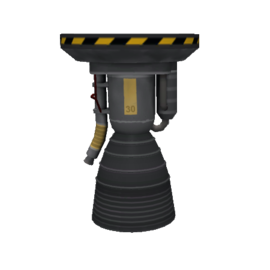Difference between revisions of "LV-T30 "Reliant" Liquid Fuel Engine"
m (Blanked the page) |
m (Reverted edits by Rocketing Rudolph (talk) to last revision by Peteletroll) |
||
| Line 1: | Line 1: | ||
| + | {{:LV-T30 Liquid Fuel Engine/Box}} | ||
| + | The '''LV-T30 Liquid Fuel Engine''' is the first liquid-fuel engine available in [[career|career mode]]. It is an engine which requires fuel from external liquid fuel tanks, and must be either connected beneath them or be on the receiving end of a [[fuel line]]. | ||
| + | |||
| + | It is similar in appearance to the [http://www.astronautix.com/engines/rs56oba.htm RS-56-OBA] booster engine used by the late [https://en.wikipedia.org/wiki/Atlas_II Atlas II] rocket. | ||
| + | |||
| + | == Usage == | ||
| + | The LV-T30 is the first [[liquid fuel]] engine with throttle control, shutdown and restart capabilities, making it easier to control vehicles safely and accurately. It also has nearly twice the specific impulse of the solid motors that went before it. This and other axially mounted engines cannot be placed radially and must be directly below a non-empty [[liquid fuel tank]] to produce any thrust. Since the tanks can be placed radially, the LV-T30 can be the basis of liquid-fueled strap-on boosters in parallel configurations. Since the engine lacks thrust vector control, other means must be incorporated to make sure the vehicle remains pointed in the right direction, such as parts with reaction wheels, aerodynamic fins and control surfaces, and parallel operating gimbaled engines such as the [[LV-T45]]. | ||
| + | |||
| + | == Product description == | ||
| + | {{Quote | ||
| + | |Although criticized by some due to their not insignificant use of so-called "pieces found lying about", the LV-T series engines have proven themselves as comparatively reliable. The T30 model boasts a failure and rattly bits ratio below the 50% mark, this has been considered a major improvement over previous models by engineers and LV-T enthusiasts. | ||
| + | }} | ||
| + | |||
| + | == Changes == | ||
| + | [[File:LVT30.png|thumb|right|Pre-0.18 appearance.]] | ||
| + | ;[[1.2]] | ||
| + | * Thrust increased from 215 to 240. | ||
| + | * Isp changed from 300 s vacuum/280 s at 1 atm to 310 s vacuum/265 s at 1 atm. | ||
| + | ;[[1.0]] | ||
| + | * Isp decreased from 370 s vacuum/320 s at 1 atm to 300 s vacuum/280 s at 1 atm. | ||
| + | * Cost increased from 850 to 1100 funds. | ||
| + | ;[[0.22]] | ||
| + | * Electricity production increased to 7.0 | ||
| + | ;[[0.18]] | ||
| + | * Retextured and remeshed | ||
| + | * Alternator added, engine now gains 1.0 electricity | ||
| + | |||
| + | ;[[0.16]] | ||
| + | * Major CFG revision (most notably Isp added) | ||
| + | ;[[0.8]] | ||
| + | * (Bug fix) Liquid Engine particle effects responding to engine cutoff | ||
| + | ;[[0.7.3]] | ||
| + | * Initial release | ||
| + | |||
| + | {{Parts}} | ||
| + | [[Category:Demo parts]] | ||
| + | [[Category:Liquid fuel engines]] | ||
Revision as of 18:27, 17 March 2017
| LV-T30 "Reliant" Liquid Fuel Engine | ||
| Liquid fuel engine by Jebediah Kerman's Junkyard and Spacecraft Parts Co | ||
| Radial size | Small | |
| Cost | (total) | 1 100.00 |
| Mass | (total) | 1.250 t |
| Drag | 0.2 | |
| Max. Temp. | 2000 K | |
| Impact Tolerance | 7 m/s | |
| Research | | |
| Unlock cost | 3 200 | |
| Since version | 0.7.3 | |
| Part configuration | liquidEngineLV-T30_v2.cfg | |
| Maximum thrust | (1 atm) | 205.16 kN |
| (vacuum) | 240.00 kN | |
| Isp | (1 atm) | 265 s |
| (vacuum) | 310 s | |
| Fuel consumption | 15.79 | |
| Thrust vectoring | No | |
| Electricity generated | 7 ⚡/s | |
| Packed volume | None | |
The LV-T30 Liquid Fuel Engine is the first liquid-fuel engine available in career mode. It is an engine which requires fuel from external liquid fuel tanks, and must be either connected beneath them or be on the receiving end of a fuel line.
It is similar in appearance to the RS-56-OBA booster engine used by the late Atlas II rocket.
Usage
The LV-T30 is the first liquid fuel engine with throttle control, shutdown and restart capabilities, making it easier to control vehicles safely and accurately. It also has nearly twice the specific impulse of the solid motors that went before it. This and other axially mounted engines cannot be placed radially and must be directly below a non-empty liquid fuel tank to produce any thrust. Since the tanks can be placed radially, the LV-T30 can be the basis of liquid-fueled strap-on boosters in parallel configurations. Since the engine lacks thrust vector control, other means must be incorporated to make sure the vehicle remains pointed in the right direction, such as parts with reaction wheels, aerodynamic fins and control surfaces, and parallel operating gimbaled engines such as the LV-T45.
Product description
| “ | Although criticized by some due to their not insignificant use of so-called "pieces found lying about", the LV-T series engines have proven themselves as comparatively reliable. The T30 model boasts a failure and rattly bits ratio below the 50% mark, this has been considered a major improvement over previous models by engineers and LV-T enthusiasts. | ” |
Changes
- Thrust increased from 215 to 240.
- Isp changed from 300 s vacuum/280 s at 1 atm to 310 s vacuum/265 s at 1 atm.
- Isp decreased from 370 s vacuum/320 s at 1 atm to 300 s vacuum/280 s at 1 atm.
- Cost increased from 850 to 1100 funds.
- Electricity production increased to 7.0
- Retextured and remeshed
- Alternator added, engine now gains 1.0 electricity
- Major CFG revision (most notably Isp added)
- (Bug fix) Liquid Engine particle effects responding to engine cutoff
- Initial release

